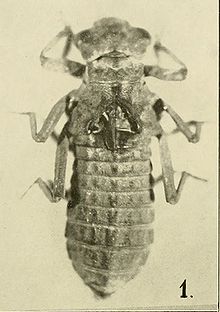Epiophlebia
| Epiophlebia | |
|---|---|
 | |
| Epiophlebia superstes adult | |
 | |
| Epiophlebia laidlawi naiad | |
| Scientific classification | |
| Domain: | Eukaryota |
| Kingdom: | Animalia |
| Phylum: | Arthropoda |
| Class: | Insecta |
| Order: | Odonata |
| Suborder: | Epiprocta |
| Infraorder: | Epiophlebioptera |
| Family: | Epiophlebiidae Tillyard, 1917 |
| Genus: | Epiophlebia Calvert, 1903 |
| Species | |
Epiophlebia is a genus of damsel-dragonfly native to the Indian subcontinent, East Asia, and Southeast Asia. It is the only living genus of Odonata to neither be a dragonfly nor a damselfly.[1] It is the sole member of the family Epiophlebiidae, which is itself the sole living representative of the infraorder Epiophlebioptera.
Description
[edit]The bodies of Epiophlebia adults have a distinctive black and yellow striped colouration. Their bodies resemble those of dragonflies, while their wings more closely resemble those of damselflies,[1] with the wings being held over the back when resting like damselflies.[2] Like in true dragonflies (Anisoptera) the aquatic nymphs breathe through a rectal chamber, but jet propulsion (which is found in true dragonflies) has not been observed.[3]
Epiophelbia flies relatively clumsily and is less manoverable than dragonflies, preferring to rapidly fly in straight lines in the shade, using a fast wingbeat with a wing motion intermediate between those of dragonflies and damselflies.[4]
Distribution
[edit]Species of Epiophlebia have a disjunct distribution, occurring in a narrow habitat of cold mountain streams at an altitude of 1,300–3,000 metres (4,300–9,800 ft) with temperatures of around 4–5 °C (39–41 °F) in winter to 16–17 °C (61–63 °F) in summer.[1] The first two species described are Epiophlebia superstes known from Japan and Epiophlebia laidlawi from the northern Indian subcontinent and northern Vietnam.[1] In 2012, a third species, Epiophlebia sinensis, was described from Heilongjiang province in northeast China, bridging Epiophlebia distribution gap between Nepal and Japan.[5] A fourth species, E. diana, has been claimed from larval material from South China, but this is not universally accepted,[6] with some authors considering it a synonym of E. laidlawi.[1] The distribution of the genus may have been continuous during Pleistocene glacial periods such as the Last Glacial Period, which may explain the genetic similarity of sequenced Epiophlebia species to each other despite the broad geographical range of the genus.[7]
Evolution
[edit]Genetic evidence suggests that Epiophlebia is overall more closely related to dragonflies than damselflies, being placed along with dragonflies in the clade Epiprocta. The lineage of Epiophlebia is suggested to have split from that of living dragonflies around the end of the Triassic, approximately 205 million years ago. Genetic evidence suggests that the lineage of Epiophlebia arose from the ancient reticulate hybridisation of a lineage related to dragonflies and lineage related to damselflies in propoportions of roughly 67% and 33%, respectively, which may explain why it combines features of both dragonflies and damselflies.[8] The genus was historically placed in the clade "Anisozygoptera" along with a variety of fossil odonatans, primarily from the Jurassic period, but this grouping was later shown to be non-monophyletic,[1] representing a paraphyletic group, with many "anisozygopterans" more closely related to dragonflies than to Epiophlebia.[9] The extinct family Burmaphlebiidae from the mid Cretaceous Burmese amber of Myanmar, dating to around 100 million years ago, may represent true close relatives of Epiophlebia.[10]
References
[edit]- ^ a b c d e f Büsse, Sebastian; Ware, Jessica L. (2022-11-02). "Taxonomic note on the species status of Epiophlebia diana (Insecta, Odonata, Epiophlebiidae), including remarks on biogeography and possible species distribution". ZooKeys. 1127: 79–90. doi:10.3897/zookeys.1127.83240. ISSN 1313-2970. PMC 9836702. PMID 36760358.
- ^ Blanke, Alexander; Beckmann, Felix; Misof, Bernhard (March 2013). "The head anatomy of Epiophlebia superstes (Odonata: Epiophlebiidae)". Organisms Diversity & Evolution. 13 (1): 55–66. doi:10.1007/s13127-012-0097-z. ISSN 1439-6092.
- ^ Büsse, Sebastian; Helmker, Benjamin; Hörnschemeyer, Thomas (2015). "The thorax morphology of Epiophlebia (Insecta: Odonata) nymphs – including remarks on ontogenesis and evolution". Scientific Reports. 5: 12835. Bibcode:2015NatSR...512835B. doi:10.1038/srep12835. PMC 4526886. PMID 26246088.
- ^ G. Rüppell & D. Hilfert. (1993). The flight of the relict dragonfly Epiophlebia superstes (Selys) in comparison with that of the modern Odonata (Anisozygoptera: Epiophlebiidae). Odonatologica, 22(3), 295–309.
- ^ Li J.-K., Nel A., Zhang X.-P., Fleck G., Gao M.-X., Lin L. & Zhou J., 2012. A third species of the relict family Epiophlebiidae discovered in China (Odonata: Epiproctophora). Systematic Entomology, 37 (2):408-412
- ^ Carle, F L (2012). "A new Epiophlebia (Odonata: Epiophlebioidea) from China with a review of epiophlebian taxonomy, life history, and biogeography". Arthropod Systematics & Phylogeny. 70 (2): 75–83. doi:10.3897/asp.70.e31750.
- ^ Goodman, Aaron M.; Beatty, Christopher D.; Büsse, Sebastian; Ubukata, Hidenori; Miyazaki, Toshiyuki; Blair, Mary E.; Ware, Jessica L. (2024-03-05). "Paleoecological niche modeling of Epiophlebia (Epiophlebioptera: Epiophlebiidae) reveals continuous distribution during the Last Glacial Maximum". International Journal of Odonatology. 27: 60–76. doi:10.48156/1388.2024.1917262.
- ^ Suvorov, Anton; Scornavacca, Celine; Fujimoto, M Stanley; Bodily, Paul; Clement, Mark; Crandall, Keith A; Whiting, Michael F; Schrider, Daniel R; Bybee, Seth M (2022-04-19). Matschiner, Michael (ed.). "Deep Ancestral Introgression Shapes Evolutionary History of Dragonflies and Damselflies". Systematic Biology. 71 (3): 526–546. doi:10.1093/sysbio/syab063. ISSN 1063-5157. PMC 9017697. PMID 34324671.
- ^ Rehn, Andrew C. (April 2003). "Phylogenetic analysis of higher‐level relationships of Odonata". Systematic Entomology. 28 (2): 181–240. doi:10.1046/j.1365-3113.2003.00210.x. ISSN 0307-6970.
- ^ Bechly, Günter; Poinar, George (April 2013). "Burmaphlebia reifi gen. et sp. nov. , the first anisozygopteran damsel-dragonfly (Odonata: Epiophlebioptera: Burmaphlebiidae fam. nov.) from Early Cretaceous Burmese amber". Historical Biology. 25 (2): 233–237. Bibcode:2013HBio...25..233B. doi:10.1080/08912963.2012.753884. ISSN 0891-2963.


 French
French Deutsch
Deutsch